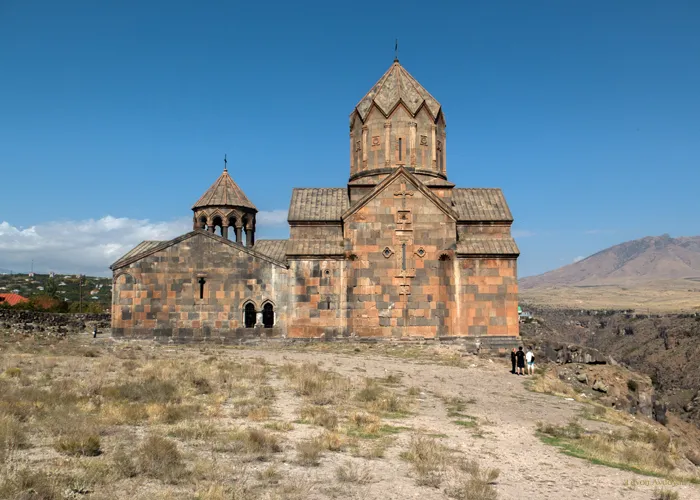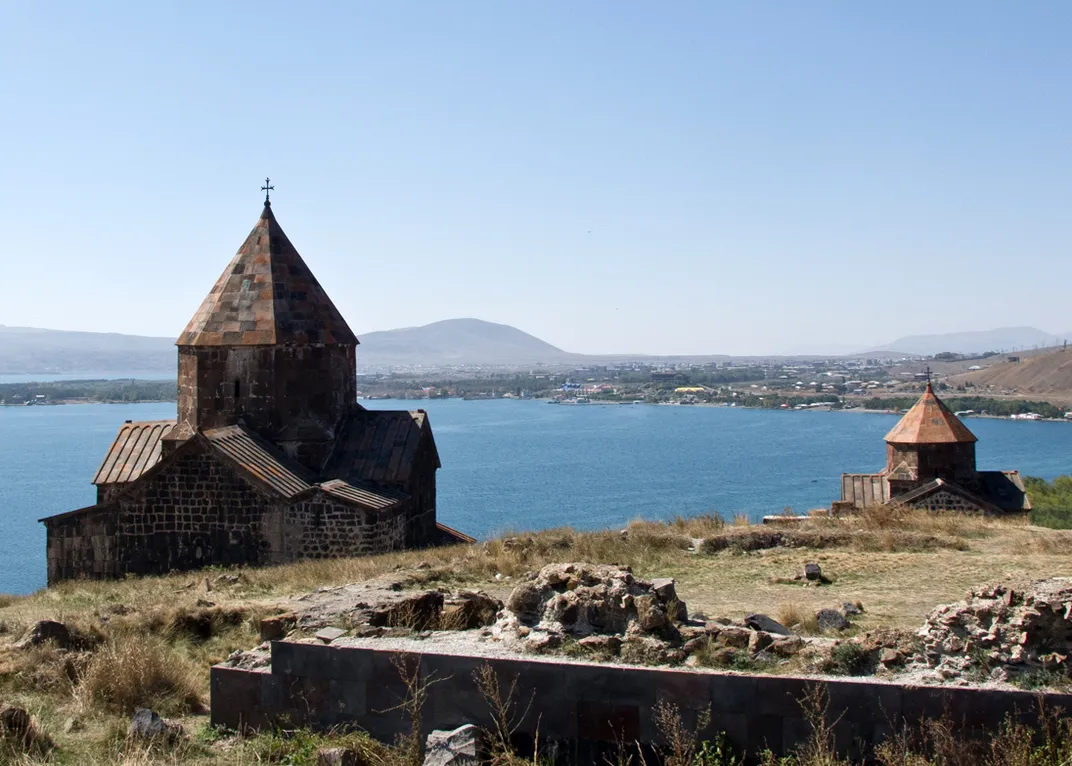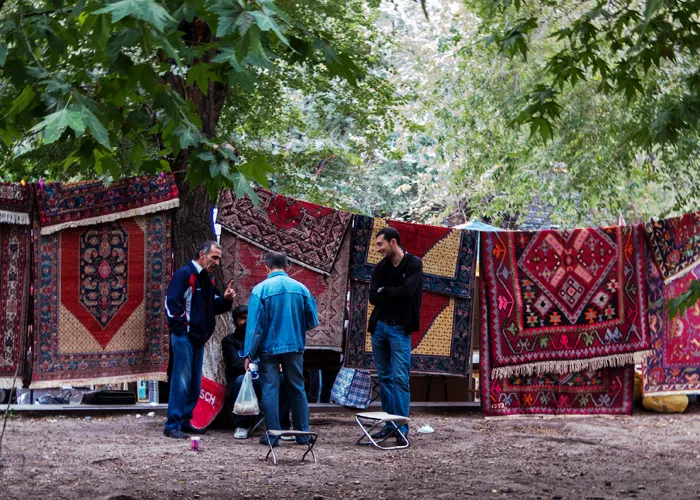Unfurling the Rich Tapestry of Armenian Culture
This year’s Smithsonian Folklife Festival will offer a window on Armenian visions of home
/https://tf-cmsv2-smithsonianmag-media.s3.amazonaws.com/filer/07/e9/07e9c4be-df97-4ca6-a414-d1e967b2da02/armenia3.jpg)
A modestly sized landlocked nation framed by the Black Sea to the west and the Caspian to the east, Armenia links the southernmost former Soviet Socialist Republics with the arid sprawl of the Middle East. Armenia’s own geography is heavily mountainous, its many ranges separated by sweeping plateaus of vivid green. The wind is stiff and the climate temperate, and the mountainsides teem with archaeological treasures of a long and meandering history.
Thousands of years ago, the land known as Armenia was roughly seven times the size of the current country. Yet even within the borders of contemporary Armenia, cathedrals, manuscript repositories, memorials and well-worn mountain paths are so dense as to offer the culturally and historically curious a seemingly endless array of avenues to explore.
This year, the Smithsonian Folklife Festival will be bringing deeply rooted Armenian culture to Washington, D.C. From food and handicrafts to music and dance, the festival, taking place in late June and early July, will provide an intimate look at an extremely complex nation. Catalonia, the autonomous region of northeast Spain, is featured alongside Armenia.
What exactly makes Armenia’s cultural landscape so fascinating?
Library of Congress Armenia area specialist Levon Avdoyan, Tufts Armenian architecture expert Christina Maranci, and the Smithsonian's Halle Butvin, curator of the festival's "Armenia: Creating Home" program explain the many nuances of the Armenian narrative.
What was Armenia’s early history like?
Given its strategic geographical status as a corridor between seas, Armenia spent much of its early history occupied by one of a host of neighboring superpowers. The period when Armenia was most able to thrive on its own terms, Levon Avodyan says, was when the powers surrounding it were evenly matched, and hence when none was able to dominate the region (historians call this principle Garsoïan’s Law, after Columbia University Armenia expert Nina Garsoïan).
Foreign occupation was often brutal for the Armenian people. Yet it also resulted in the diversification of Armenian culture, and allowed Armenia to exert significant reciprocal influence on the cultures of its invaders. “Linguistically, you can show that this happened,” Avodoyan says. “Architecturally this happened.” He says Balkan cruciform churches may very well have their artistic roots in early Armenian designs.
/https://tf-cmsv2-smithsonianmag-media.s3.amazonaws.com/filer/89/8a/898a9e8c-059e-4860-8ac0-b12ff03e41a8/armenia1.jpg)
What religious trends shaped Armenia?
It’s hard to say what life looked like in pre-Christian Armenia, Avdoyan admits, given that no Armenian written language existed to record historical events during that time. But there are certain things we can be reasonably sure about. Zoroastrianism, a pre-Islamic faith of Persian origin, predominated. But a wide array of regionally variant pagan belief systems also helped to define Armenian culture.
The spontaneous blending of religious beliefs was not uncommon. “Armenia was syncretistic,” Avdoyan says, meaning that the religious landscape was nonuniform and ever-changing . “The entire pagan world was syncretistic. ‘I like your god, we’re going to celebrate your god. Ah, Aphrodite sounds like our Arahit.’ That sort of thing.”
Armenia has long had strong ties with Christian religion. In fact, Armenia was the first nation ever to formally adopt Christianity as its official faith, in the early years of the fourth century A.D. According to many traditional sources, says Levon Avdoyan, “St. Gregory converted King Tiridates, and Tiridates proclaimed Christianity, and all was well.” Yet one hundred years after this supposedly smooth transition, acceptance of the new faith was still uneven, Avdoyan says, and the Armenian language arose as a means of helping the transition along.
“There was a plan put forth by King Vramshapu and the Catholicos (church patriarch) Sahak the Great to invent an alphabet so that they could further propagate the Christian faith,” he explains.
As the still-employed Greek-derived title “Catholicos” suggests, the Christian establishment that took hold in the fourth century was of a Greek orientation. But there is evidence of Christianity in Armenia even before then—more authentically Armenian Christianity adapted from Syriac beliefs coming in from the south. “From Tertullian’s testimony in the second century A.D.,” says Avdoyan, “we have some hints that a small Armenian state was Christian in around 257 A.D.”
Though this alternative take on Christianity was largely snuffed out by the early-fourth century pogroms of rabidly anti-Christian Roman Emperor Diocletian, Avdoyan says facets of it have endured to this day, likely including the Armenian custom of observing Christmas on January 6.
How did Armenia respond to the introduction of Christian beliefs? With the enshrinement of Christianity came a period characterized by what Avdoyan generously terms “relative stability” (major instances of conflict—including a still-famous battle of 451 AD that pitted Armenian nobles against invading Persians eager to reestablish Zoroastrianism as the official faith—continued to crop up). Yet the pagan lore of old did not evaporate entirely. Rather, in Christian Armenia, classic pagan myth was retrofitted to accord with the new faith.
“You can tell that some of these tales, about Ara the Beautiful, etc., have pagan antecedents but have been brought into the Christian world,” Avdoyan says. Old pagan themes remained, but the pagan names were changed to jibe with the Christian Bible.
The invention of an official language for the land of Armenia meant that religious tenets could be disseminated as never before. Armenia’s medieval period was characterized by the proliferation of ideas via richly detailed manuscripts.

What was special about medieval Armenia?
Armenian manuscripts are to this day world-renowned among medieval scholars. “They’re remarkable for their beauty,” Avdoyan says. Many have survived in such disparate places as the Matenadaran repository in Yerevan, the Armenian Catholic monasteries of San Lazzaro in Venice, and the Walters Art Museum in Maryland.
Historians define “medieval Armenia” loosely, but Avdoyan says most place its origin in the early fourth century, with the arrival of Christianity. Some, like Avodyan, carry it as far forward as the 16th century—or even beyond. “I put it with 1512,” Avdoyan says, “because that’s the date of the first published book. That’s the end of the manuscript tradition and the beginning of the print.”
What sets the manuscripts apart is their uniquely ornate illuminated lettering. “The Library of Congress recently bought a 1486 Armenian gospel book,” Avdoyan says, “and our conservationists got all excited because they noticed a pigment that didn’t exist in any other.” Discoveries like this are par for the course with Armenian manuscripts, which continue to draw academic fascination. “There’s still a lot to be learned about the pigments and styles.”
The structure of life in medieval Armenia was a far cry from what Westerners tend to picture when they hear the term “medieval.” A kind of feudalism did take hold for a time, Avdoyan says, but not that of lordships and knights. “Unlike feudalism in Europe, which was tied to the land,” he notes, “feudalism in Armenia was tied to the office. You had azats, the free, you had the nobles, and in a certain period you had the kings.” For a stretch of Armenian history, these divisions of office were rigidly enforced—everyone knew their place. “But by the ninth century, tenth century, it rather fell apart.”
One facet of Armenia’s medieval period that was more consistent was the majesty of the churches and other religious structures erected all across its mountainous topography. These creations are the focus of medieval Armenian art historian Christina Maranci.
/https://tf-cmsv2-smithsonianmag-media.s3.amazonaws.com/filer/e6/d4/e6d4f61a-33a9-4963-b95c-fba130f026a3/armenia5.jpg)
Armenians take pride in their historic architecture. Why?
It is something of a rarity for a country’s distinctive architecture to inspire ardent national pride, but Christina Maranci says such is most definitely the case in Armenia. “Many Armenians will tell you about Armenian architecture,” she says. To this day, engineering is a highly revered discipline in Armenia, and many study it. “A lot of Armenians know very well how churches are built, and are proud of that.”
Maranci says that what makes Armenian art history so fascinating to study, even before the medieval period, is its simultaneous incorporation of outside techniques and refinement of its native ones. Before Christianity, she says, “you have what you would traditionally consider to be Near Eastern art—Assyrian art, Persian—but you also have evidence for Mediterranean classical traditions, like Hellenistic-looking sculpture and peristyles. Armenia provides a very useful complication of traditional categories of ancient art.”
But later architecture of the region—particularly the Christian architecture of the medieval period—is what it is best known for today.
How far back can we trace Armenian architecture?
With the dawn of national Christianity, Byzantine and Cappadocian influences began to take hold. And places of worship began to dot the land. “The first churches upon the conversion of Armenia to Christianity are largely basilicas,” Maranci notes. “They’re vaulted stone masonry structures, but they don’t use domes for the most part, and they don’t use the centralized planning” that many later Armenian churches claim as a hallmark.
By the seventh century, though, Maranci explains that Armenia began to embrace its own signature architectural style. “You have the domed centralized plan,” she says, which “is distinctive to Armenia and neighboring Georgia, and is distinct from Byzantine architecture, Syrian architecture and Cappadocian architecture.” Within the span of just a few decades, she says, centrally planned churches came to predominate in Armenia. And “it becomes ever more refined through the tenth century, eleventh century, and so on.”
As important in medieval Armenian church architecture as the churches themselves was their situation amid the natural flow of their surroundings. “The outside of the church was, from what we can tell, used in processions and ceremonies as well as the inside,” Maranci says. “In traditional Armenian churches, you see very clearly the way the church building is related to the landscape. That’s another piece that’s important.”
Many of these elegantly geometric models have endured in Armenian architecture through to the present day. Yet Maranci says that the Hamidian Massacres of the 1890s and the Armenian Genocide of 1915 to 1922 have exerted undeniable influences on Armenian architecture and art more broadly. “The recovery of medieval form now has to be mediated through this trauma,” she says. Modern Armenian art often subverts medieval forms to illustrate the annihilating effect of the bloodshed.
Moreover, since many Armenians emigrated out of the nation during or in the wake of these dark periods, diasporic Armenians have had to come up with their own takes on the traditional in new, unfamiliar environs. “You can see how American churches use prefab forms to replicate the Armenian churches,” she says by way of example. In lieu of Armenia’s incredibly sturdy rubble masonry technique—which dates back nearly two millennia—American communities have made do with plywood, drywall and reinforced concrete, improvising with their own materials yet staying true to the ancient architectural layouts.

What is significant about the Armenian diaspora(s)?
Many have heard the phrase “Armenian diaspora,” generally used as a blanket term to encompass those Armenians who fled the region around the time of the genocide and other killings. During and after World War I, an estimated 1.5 million Armenians were killed—the Turkish government, for its part, disputes the death toll and denies that there was a genocide.
Avdoyan notes that, really, there was no one diaspora, but rather many distinct ones across a wide stretch of history. By using the singular term “diaspora,” Avdoyan believes we impute to the various immigrant groups of Armenia a sense of cohesion they do not possess.
“There is no central organization,” he says. “Each group has a different idea of what it means to be Armenian. Each one has a feeling that their Armenian-ness is more genuine or more pure. And it’s also generational.” The Armenians who fled the genocide have identities distinct from those of emigrants who left Armenia after the Lebanese Civil War, and distinct in a different way from those of the emigrants who have left Armenia since it secured its independence from the Soviet Union in 1990. Avodoyan hopes that one day all the different diasporic generations will be able to come together for a cultural conference.

What aspects of Armenian culture will the Folklife Festival be highlighting?
Between the rich artistic and religious history of the Armenian homeland and the various cultural adaptations of diasporic Armenian populations worldwide, the Smithsonian Center for Folklife and Cultural Heritage had its work cut out for it in selecting elements of Armenian culture to showcase at this year’s Folklife Festival. The Folklife team settled on two major themes to explore—feasting and craft. These will be presented through the lens of home, an essential concept throughout the Armenian narrative.
On every day of the festival, which runs from June 27-July 1 and July 4-July 8, a dedicated “demonstration kitchen” will hold hourly presentations of Armenian recipes in action. Festival curator Halle Butvin calls special attention to Armenian methods of preserving food: “cheesemaking, pickling, making jams and drying herbs and fruits.”
The demonstration kitchen will also be showing off recipes featuring foraged foods, in honor of the self-sufficient food-gathering common in mountainous Armenia, as well as foods tied to the time-honored ritual of coming together for feasting: “Armenian barbecue, tolma, lavash, cheese, different salads. . . some of the major staples of an Armenian feast.”
Linked to feasting is Armenia’s dedication to its national holidays. “Vardavar, a pagan water-throwing tradition takes place on July 8 and Festivalgoers will get a chance to participate,” Butvin says. She says celebrants can expect to learn how to make such treats as gata (sweet bread), pakhlava (filo pastry stuffed with chopped nuts) and sujukh (threaded walnuts dipped in mulberry or grape syrup) for the occasion.
Diasporic Armenian eats will be prepared as well as time-honored homeland fare. Since “Armenian cultural life really does revolve around the home,” Butvin says, “we’ll have the whole site oriented around that, with the hearth—the tonir—at the center.”
Tonirs, the clay ovens in which Armenian lavash bread is cooked, are traditionally made specially by highly skilled Armenian craftsmen. One such craftsman will be on site at the Folklife Festival, walking visitors through the process by which he creates high-performance high-temperature ovens from scratch.
Another featured craft which speaks to the value Armenians place on architecture is the stone carving technique known as khachkar. Khachkars are memorial steles carved with depictions of the cross, and are iconic features of Armenian places of worship. Visitors will get hands-on exposure to the art of khachkar, as well as other longstanding Armenian specialties like woodcarving and rugmaking.
Musically, guests can expect a piquant blend of Armenian jazz and folk tunes. Butvin is looking forward to seeing the camaraderie between the various acts in the lineup, who all know one another and will be building on each other’s music as the festival progresses. “They will play in different groupings,” Butvin says—guests can expect “a lot of exchanges and influences taking place between the artists.”
And what would music be without dance? Butvin says the dance instruction component of the Folklife Festival will tie in thematically with the feasting traditions emphasized among the culinary tents. “Usually you eat, drink, listen to music, and then dance once you’re feeling a little tipsy,” Butvin says. “That’s kind of the process of the feast.”
The emphasis of the Armenian portion of the festival on home and family will contrast well with the Catalonian activities’ stress on street life. “The whole Catalonian site is focused around the street and the plaza and this public space,” Butvin says, “whereas the Armenia side is really focused on the home itself. It will be an interesting difference, to look at the two.”
Butvin is hopeful the festival will show visitors the wonders of Armenian culture while also impressing upon them the degree to which it has spread and evolved all over the globe. “All of these different objects and traditions help to create a sense of home for Armenians,” she says—even those Armenians “who are in diaspora, who are trying to hold on to this sense of Armenian-ness.”
The Smithsonian Folklife Festival takes place on the National Mall in Washington, D.C., June 27 to July 1, and July 4 to July 8, 2018. Featured programs are "Catalonia: Tradition and Creativity from the Mediterranean" and "Armenia: Creating Home."
/https://tf-cmsv2-smithsonianmag-media.s3.amazonaws.com/accounts/headshot/DSC_02399_copy.jpg)
/https://tf-cmsv2-smithsonianmag-media.s3.amazonaws.com/accounts/headshot/DSC_02399_copy.jpg)